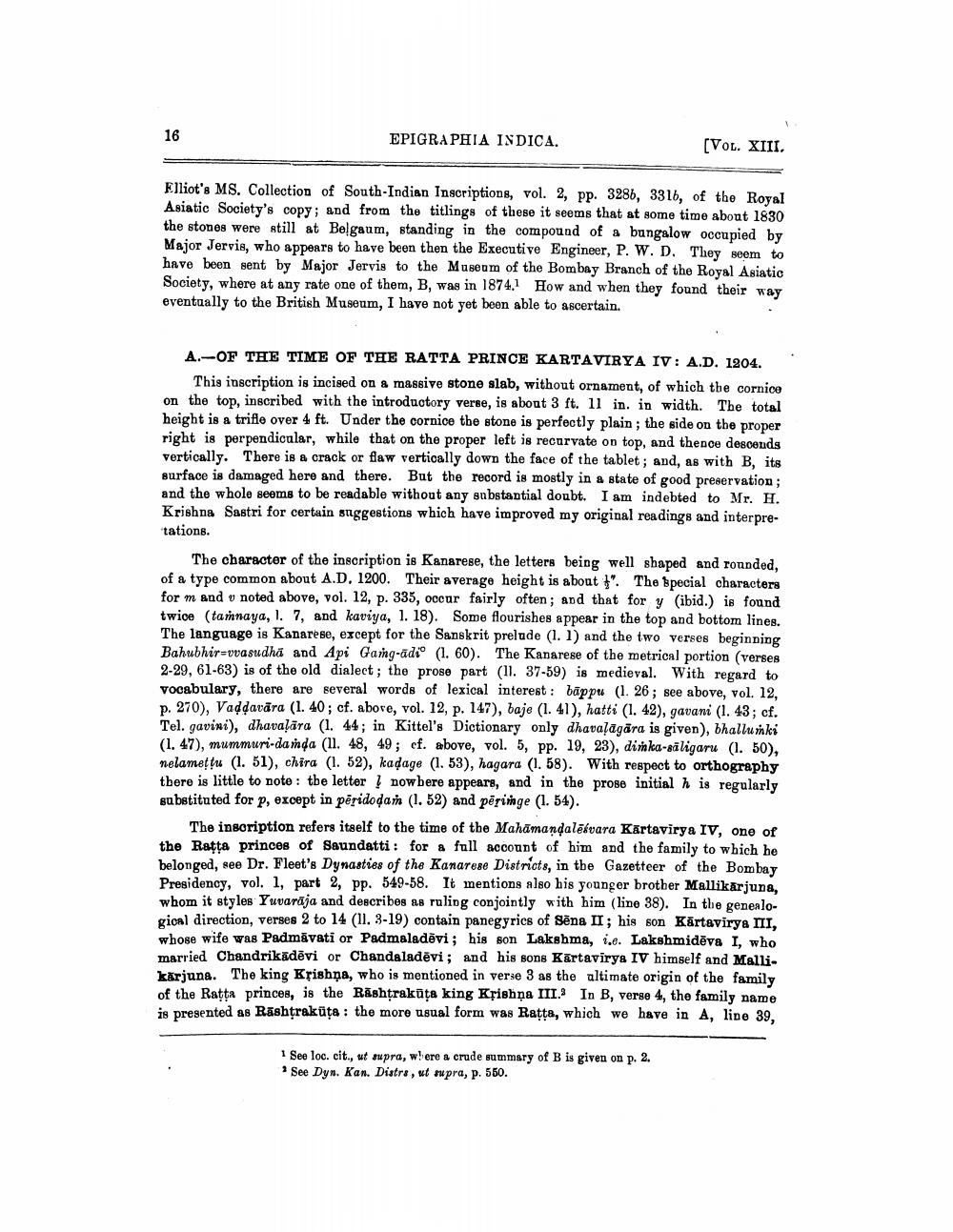________________
EPIGRAPHIA INDICA.
(VOL. XIII.
Elliot's MS. Collection of South Indian Inscriptions, vol. 2, pp. 3286, 3316, of the Royal Asiatic Society's copy; and from the titlings of these it seems that at some time about 1830 the stones were still at Belgaum, standing in the compound of a bungalow occupied by Major Jervis, who appears to have been then the Executive Engineer, P. W. D. They seem to have been sent by Major Jervis to the Museum of the Bombay Branch of the Royal Asiatic Society, where at any rate one of them, B, was in 1874.1 How and when they found their way eventually to the British Museum, I have not yet been able to ascertain.
A.-OF THE TIME OF THE RATTA PRINCE KARTAVIRYA IV: A.D. 1204
This inscription is incised on a massive stone slab, without ornament, of which the cornice on the top, inscribed with the introductory verse, is about 3 ft. ll in. in width. The total height is a trifle over 4 ft. Under the cornice the stone is perfectly plain; the side on the proper right is perpendicular, while that on the proper left is recurvate on top, and thence descends vertically. There is a crack or flaw vertically down the face of the tablet; and, as with B, its surface is damaged here and there. But the record is mostly in a state of good preservation; and the whole seems to be readable without any substantial doubt. I am indebted to Mr. H. Krishna Sastri for certain suggestions which have improved my original readings and interpretations.
The character of the inscription is Kanarese, the letters being well shaped and rounded, of a type common about A.D. 1200. Their average height is about ". The special characters for m and v noted above, vol. 12, p. 335, occur fairly often; and that for y(ibid.) is found twice (tamnaya, 1. 7, and kaviya, 1. 18). Some flourishes appear in the top and bottom lines. The language is Kanarese, except for the Sanskrit prelude (1.1) and the two verses beginning Bahubhir=vvasudha and Api Gang-adio (1. 60). The Kanarese of the metrical portion (verses 2-29, 61-63) is of the old dialect; the prose part (11. 37-59) is medieval. With regard to vocabulary, there are several words of lexical interest : bāppu (l. 26; see above, vol. 12, p. 270), Vaddavāra (1. 40; cf. abore, vol. 12, p. 147), baje (1. 41), hatti (1. 42), gavani (1. 43; cf. Tel. gavini), dhavaļāra (1. 44; in Kittel's Dictionary only dhavaļāgāra is given), bhallurki (1. 47), mummuri-danda (11. 48, 49; cf. above, vol. 5, pp. 19, 23), dirka-säligaru (1. 50), nelamettu (1. 51), chira (1. 52), kadage (1. 53), hagara (1. 58). With respect to orthography there is little to note: the letter now bere appears, and in the prose initial h is regularly substituted for p, except in pēridodan (1. 52) and pēringe (1. 54).
The inscription refers itself to the time of the Mahamandalēkvara Kārtavirya IV, one of the Ratta princes of Saundatti: for a full account of him and the family to which he belonged, see Dr. Fleet's Dynasties of the Kanarese Districts, in the Gazetteer of the Bombay Presidency, vol. 1, part 2, pp. 549-58. It mentions also his younger brother Mallikarjuna, whom it styles Yuvaraja and describes as ruling conjointly with him (line 38). In the genealogical direction, verses 2 to 14 (11, 3-19) contain panegyrics of Sēna II; his son Kärtavirya III, whose wife was Padmăvati or Padmaladēvi ; his son Lakshma, i.e. Lakshmidēva I, who married Chandrikadēvi or Chandaladēvi; and his sons Kartavirya IV himself and Mallikarjuna. The king Krishna, who is mentioned in verse 3 as the altimate origin of the family of the Ratta princes, is the Răshtrakūta king Krishna III. In B, verse 4, the family name is presented as Rashtraküța : the more usual form was Ratta, which we have in A, line 39,
1 See loc. cit., ut supra, were a crude summary of B is given on p. 2.
See Dyn. Kan. Distrs, ut supra, p. 550.




